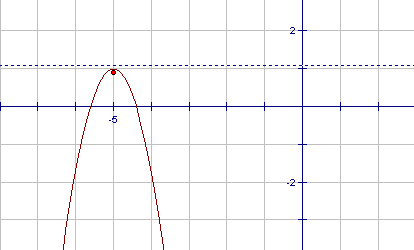 Equations of Simple Parabolas (Part 2)
Equations of Simple Parabolas (Part 2)
(This page is Part 2. Click here for Part 1.)
Shifting the Parabola
Now, here's some very good news. By using graphical transformations, knowledge of this one simple equation $\,y = ax^2\,$ actually gives full understanding of all parabolas with directrix parallel to the $x$-axis! The results are summarized next.
Shift the parabola (together with its focus and directrix) horizontally by $\,h\,,$ and vertically by $\,k\,.$ This yields the following information:
Example (Graphing a Shifted Parabola)
In this example, I illustrate the approach that I usually take when asked to give complete information about the parabola $\,y = a(x-h)^2 + k\,.$
-
Concave up or down? Since $\,a=-3\lt 0\,,$ the parabola is concave down (sheds water). Since the focus is always inside a parabola, we know the focus is under the vertex.
-
Find the vertex: The vertex of $\,y = a(x-h)^2 + k\,$ is the point $\,(h,k)\,$:
$$ \cssId{s34}{y = a( \overset{\text{What value of } \ x\ }{\overset{\text{ makes this zero?}}{\overbrace{ \underset{\text{answer: } \ h}{\underbrace{x-h}}}}})^2\ \ \ + \overset{y\text{-value of the vertex}}{\overbrace{\ \ k\ \ }}} $$For us, what makes $\,x+5\,$ equal to zero? Answer: $\,-5\,$
Thus, $\,-5\,$ is the $x$-value of the vertex. When $\,x = -5\,,$ the corresponding $y$-value is $\,1\,.$ Thus, the vertex is $\,(-5,1)\,.$
-
Find the distance from the vertex to the focus: Using the ‘one over four pee pair’ memory device:
$$\cssId{s42}{p = \frac{1}{4a} = \frac{1}{4(-3)} = -\frac{1}{12}}$$Thus, the distance from the focus to the vertex is:
$$\cssId{s44}{|p| = \left|-\frac1{12}\right| = \frac{1}{12}}$$ -
Find the focus: We already determined that the focus lies below the vertex. So, the focus is:
$$\cssId{s48}{(-5,1-\frac{1}{12}) =(-5,\frac{11}{12})}$$ -
Find the equation of the directrix: Every horizontal line has an equation of the form:
$$\cssId{s51}{y = \text{(some #)}}$$In our example, the focus lies $\,\frac{1}{12}\,$ below the vertex, so the directrix lies $\,\frac{1}{12}\,$ above the vertex. Thus, the equation of the directrix is $\,y=1+\frac{1}{12}\,,$ that is, $\,y=\frac{13}{12}\,.$
-
Plot an additional point: Plotting an additional point gives a sense of the ‘width’ of the parabola. For example, when $\,x = -4\,$ we have:
$$ \begin{align} y &= -3(-4+5)^2 + 1\cr &= -3(1) + 1\cr &= -2 \end{align} $$In this parabola, the vertex is close to the focus, so the parabola is narrow.
 $\,y=-3(x+5)^2+1\,$
$\,y=-3(x+5)^2+1\,$
For fun, zip up to WolframAlpha and type in any of the following:
vertex of y = -3(x+5)^2 + 1
focus of y = -3(x+5)^2 + 1
directrix of y = -3(x+5)^2 + 1
How easy is that?!